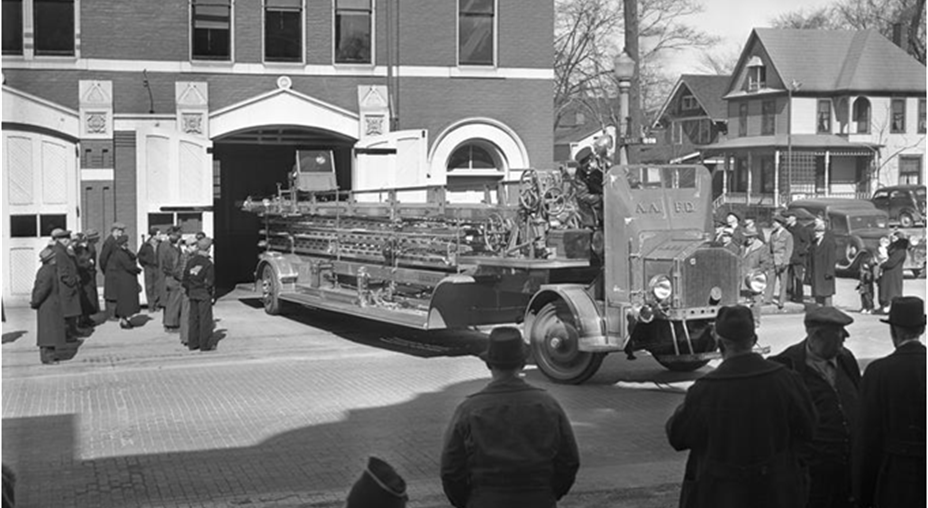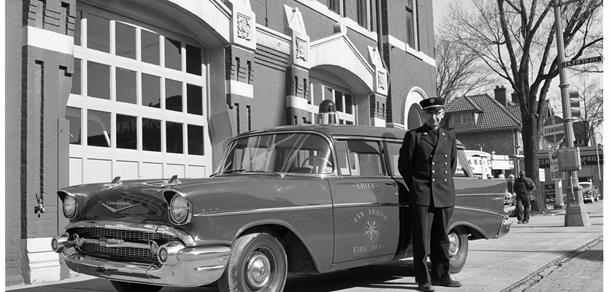Historical Narrative

Ann Arbor was first settled in 1824 as “ Annarbour,” then became a chartered city in 1851.
The City fire protection services were established between 1836 and 1838. At that time, Ann Arbor divided into two wards, each with its own fire warden, volunteer fire company,and engine house. Nearly fifty years later, an elegant “Fireman’s Hall” was built at Fifth Avenue and Huron Street, which is now home to the Ann Arbor Hands-On Museum.
On June 18, 1845, a public meeting was called “on account of the recent destruction of a large amount of property by fire and the alarming danger to which the whole of lower town is exposed calls for some efficient measures of protection.” Lower Town was the section north of the Huron River. The meeting recommended to the Village Board of Trustees purchase 100 feet of hose, a small ladder and “several dozen” fire helmets. A code of fire rules was adopted which stated, "Upon hearing the cry of fire, every citizen, under 'pain of punishment' must call “fire” at the top of his lungs and go to the scene with a bucket or pail."
Eagle Fire Company No. 2 was organized January 28, 1859. Eagle Fire Company No. 1 was reorganized in 1864, under Chief Engineer Charles Tripp. At that time fire equipment consisted of hand pump engines, with the firemen being all volunteers.
On April 18, 1854, it was stated “Resolved. That we the members of the several Fire Companies of the City of Ann Arbor feeling the necessity of a unity of interest as well as unity of action, and for the purpose of creating such unity, do herby organize ourselves into a General Association to be known as the Fire Department of the City of Ann Arbor.”
In 1871 a new fire bell was purchased, but it proved to be too large for the tower and a different one had to be ordered. The present “Firemen’s Hall” on Huron Street was built in the 1880’s for $12,000. It housed the volunteer firemen’s equipment. For fighting fires, the fire department had to depend on stored rainwater. It was not until December 1, 1885 that the city water system was completed, including 100 hydrants.
The “all-volunteer fire department” was supplement by one professional in 1888, when Christopher Matthews was hired to be at the engine house at all times. Three all-volunteer fire companies the city.
Huron Fire Company was located north of the railroad tracks, just off Broadway.
Peerless Fire Company was near the old Tappan School at College Street and East University Ave.
Defiance Fire Company was eventually located in the present Central Fire Station (now headquarters).
The City Council meeting of February 4, 1889 authorized the hiring of men and horses for a sixty-day trail of a professional department. This had become necessary due to the disbanding of the volunteer departments. Fred Sipley was appointed as the first fire chief. In 1890, the population of Ann Arbor was 9,431. The fire department consisted of three paid men, one team of horses, and one hose wagon. When not fighting fires, the horses were used to plow city land.
By the turn of the century, the Ann Arbor fire Department was well established as a professional fire fighting organization. With two stations, a variety of equipment, and full-time, paid personnel, the Firemen worked to protect the lives and property of the citizens of Ann Arbor.
References:“The Ann Arbor Fire Fighter 1888-1972, produced & Published by Phil Johnson and Associates” & “Ann Arbor-A Pictorial History by Marilyn McLaughlin”
Timeline

1824 Village of Ann Arbor Founded.
1836 Village passes ordinance establishing Fire Department.
1837 First hand drawn fire engine purchased.
First water cistern was built at Main and Huron.
Ann Arbor Fire Company 2 formed.
1845 First "hook and ladder" and a dozen fire helmets purchased.
1840's Wooden fire station built at Fifth Avenue and Huron.
1849 Eagle Fire Company 1 and 2 formed.
1850 Deluge, Relief, and Huron companies formed.
1851 Village becomes a City.
1854 Volunteer fire companies unit to become known as "Fire Department of the City of Ann Arbor."
1865 Defiance Hook and Ladder Company No.1 organized. Seven different fire companies were represented in the city. Specialized hose crews and hook and ladder crews established.
1881 Heavy steam engine (self pumping) purchased.
1882 New brick fire house built at Fifth Avenue and Huron Street. The Vigilant, Protection, Defiance and Huron fire companies protect the city with 105 fire fighters. First team of horses replaces men pulling apparatus.
1885 Water system with 100 hydrants is installed in city
1886 Fred Siply is appointed fire chief and serves until 1906.
1888 Two fulltime fireman hired, with the rest being volunteers. Huron, Peerless and Defiance companies still remain. Fred Sipley appointed as fire chief.
1889 Hiring of men and horses for a 60-day trial period of a professional department. Population is 11,000.
1894 First mutual response to the City of Ypsilanti for a fire at the high school. The horse's response time was 38 minutes, each losing 30 pounds. There were around 50 alarms in the city that year.
1905 Second fire station built on East University.
1906 Charles Edwards is appointed fire chief and serves until 1907.
1907 Charlie Andrews is appointed fire chief and serves until 1939.
1915 First motorized American LaFracne fire apparatus is purchased. The AAFD Honor Guard Fire Bell still uses the bell from this vehicle. The city has 270 hydrants.
1925 The last three horses are retired. Their names were Duke, Jim, and Barney. The city has 360 hydrants.
1928 Firefighter Matthew Heininger dies in the line of duty.
1930 AAFD has thirty men and six fire apparatus. Population 36,000. The city has 400 hydrants.
1939 Ben Zahn Sr is appointed fire chief and serves until 1955.
1953 Fire Station 2 opens at Stadium Blvd and Packard.
1955 Ernst Heller is appointed fire chief and serves until 1965.
1957 City of East Ann Arbor is annexed. Station 2½ is at Platt and Packard.
1960 First rescue squad placed in service.
1961 Firefighter Henry Clement dies in the line of duty.
1963 Fire Station 3 opens on Jackson Ave east of Maple Road.
1965 Arthur Stauch is appointed fire chief and serves until 1974.
1966 Fire Station 4 opens and Huron Parkway south of Washtenaw Ave.
1967 Fire Station 5 opens on Beal Ave (U-M North Campus)
1967 Michael Jackson hired as first AAFD African American firefighter. He retired as an assistant chief.
1971 AAFD responded on 1043 incidents.
1974 Fred Schmid is appointed fire chief and serves until 1985.
1978 New Fire Station 1 opens at Fifth Avenue and Ann Street.
1980 Mindy Kerr hired as first AAFD female firefighter.
1981 Fire Station 6 opens on Briarwood Circle. Engine 2 is relocated to Station 6. AAFD has six fire stations, staffing nine fire trucks
1986 AAFD responded on 4986 incidents.
1987 Robert Murphy is appointed fire chief and serves until 1988.
1988 George Markus is appointed fire chief and serves until 2001.
1991 Ladder 1 is removed from service.
2001 AAFD responded on 9475 incidents.
2003 Joseph Gorman is appointed fire chief, serves until 2005.
2003 Fire Station 2 is closed. Ladder 2 and Engine 1 are removed from service.
2005 Sam Hopkins is appointed fire chief and serves until 2009.
2006
Firefighter Amy Schnearle-Pennywitt dies in the line of duty. She was killed after being struck by vehicle on I-94 at Jackson Avenue.
2008 The city has 3550 hydrants.
2010 Dominick Lanza is appointed fire chief and serves until 2011.
2011 Ollice Hubbard is appointed fire chief and serves until 2013.
2015 Larry Collins is appointed fire chief and serves until 2018.
2018 Mike Kennedy is appointed fire chief.
2023 ISO (insurance) rating is lowered from 3 to 2.
2023 First fire department ambulance is placed in-service. Fire department is licensed as basic life support transport agency.
Historical note:
“First Call" is believed to be a term unique to AAFD. It was used from the 1800s through the 2000's. Originally, when a "first call" was announced, the engine and ladder company in the front of the station responded. A "second call" meant the fire apparatus in the back of the station would respond. Eventually, it meant the first alarm to a reported structure.
